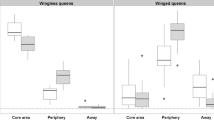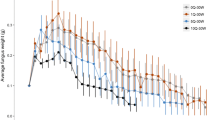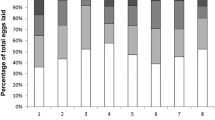Abstract
Alate trapping studies of a monogyne population of the fire ant Solenopsis geminata indicate that two sizes of gynes are produced. Macrogynes, which participate in late spring and summer mating flights, are larger, fattier, and more than twice as heavy as microgynes, which participate in fall mating flights. Three patterns of gyne production were observed in 51 colonies studied: 35 produced macrogynes only, 9 produced microgynes only, and 7 produced both morphs, contributing to both summer and fall mating flights. Behavioral evidence and rearing studies suggest that macrogynes found new colonies independently, whereas microgynes achieve colony queen status by infiltrating or being adopted by established colonies. Of the total number of female alates collected from the trapped colonies, 56% were microgynes. However, because of their smaller size and lower fat content, microgynes made up only one-third of the caloric investment in female alates. By measuring the thorax lengths of queens from mature colonies, we determined that at least 56% were macrogynes and 35% or more were microgynes. These results indicate that as a reproductive strategy, colony investment in microgyne production may have at least as high a payoff as investment in macrogyne production.
Similar content being viewed by others
References
Adams CT, Banks WA, Plumley JK (1976) Polygyny in the tropical fire ant, Solenopsis geminata with notes on the imported fire ant, Solenopsis invicta. Fla Entomol 59:411–415
Austad SN (1984) A classification of alternative reproductive behaviors and methods for field-testing ESS models. Amer Zool 24:309–320
Bourke A, Franks NR (1991) Alternative adaptations, sympatric speciation and the evolution of parasitic, inquiline ants. Biol J Linn Soc 43:157–178
Brian MV (1965) Social insect populations. Academic Press, London
Brian MV, Brian AD (1949) Observations on the taxonomy of the ants Myrmica rubra L. and M. laevinodis Nylander (Hymenoptera: Formicidae). Trans R Entomol Soc Lond 100:393–409
Brian MV, Brian AD (1955) On the two forms macrogyna and microgyna of the ant Myrmica rubra L. Evolution 9:280–290
Briese DT (1983) Different modes of reproductive behaviour (including a description of colony fission) in a species of Chelaner (Hymenoptera: Formicidae). Insectes Soc 30:308–316
Buschinger A (1968) Mono- und Polygynie bei Arten der Gattung Leptothorax Mayr (Hymenoptera Formicidae). Insectes Soc 15:217–226
Buschinger A (1986) Evolution of social parasitism in ants. Trends Ecol Evol 1:155–160
Buschinger A (1990) Sympatric speciation and radiative evolution of socially parasitic ants — heretic hypotheses and their factual background. Z Zool Syst Evolut Forsch 28:241–260
Buschinger A, Heinze J (1992) Polymorphism of female reproductives in ants. In: Billen J (ed) Biology and evolution of social insects. Leuven University Press, Leuven, Belgium, pp 11–23
Cherix D, Chautems D, Fletcher DJC, Fortelius W, Gris G, Keller L, Passera L, Rosengren R, Vargo EL, Walter F (1991) Alternative reproductive strategies in Formica lugubris Zett. Ethol Ecol Evol Special Issue 1:61–66
Elmes GW (1978) A morphometric comparison of three closely related species of Myrmica (Formicidae), including a new species from England. Syst Entomol 3:131–145
Elmes GW (1991) Mating strategy and isolation between the two forms, macrogyna and microgyna, of Myrmica ruginodis (Hym. Formicidae). Ecol Entomol 16:411–423
Fortelius W, Pamilo P, Rosengren R, Sundstrom L (1987) Male size dimorphism and alternative reproductive tactics in Formica exsecta ants (Hymenoptera, Formicidae). Ann Zool Fennici 24:45–54
Franks NR, Hölldobler B (1987) Sexual competition during colony reproduction in army ants. Biol J Linn Soc 30:229–243
Harrison RG (1980) Dispersal polymorphisms in insects. Annu Rev Ecol Syst 11:95–118
Herbers JM (1993) Ecological determinants of queen number in ants. In: Keller L (ed) Queen number and sociality in insects. Oxford University Press, Oxford, pp 262–293
Hölldobler B, Wilson EO (1977) The number of queens: an important trait in ant evolution. Naturwissenschaften 64:8–15
Holldobler B, Wilson EO (1990) The Ants. Belknap Press, Cambridge
Janzen DH (1973) Evolution of polygynous obligate acacia-ants in western Mexico. J Anim Ecol 42:727–750
Kasugai M, Takeda S, Sakurai H (1983) Observations on the microgyne form of ant Myrmica ruginodis Nylander (Hymenoptera, Formicidae) in Sapporo. Kontyu 51:73–79
Keller L (1991) Queen number, mode of colony founding, and queen reproductive success in ants (Hymenoptera, Formicidae). Ethol Ecol Evol 3:307–316
Keller L (1993) Queen number and sociality in insects. Oxford University Press, Oxford
Keller L, Passera L (1989) Size and fat content of gynes in relation to the mode of colony founding in ants (Hymenoptera; Formicidae). Oecologia 80:236–240
Keller L, Ross KG (1993a) Phenotypic plasticity and “cultural transmission” of alternative social organizations in the fire ant Solenopsis invicta. Behav Ecol Sociobiol 33:121–129
Keller L, Ross KG (1993b) Phenotypic basis of reproductive success in a social insect: genetic and social determinants. Science 260:1107–1110
Lenoir A, Querard L, Pondicq N, Berton F (1988) Reproduction and dispersal in the ant Cataglyphis cursor (Hymenoptera, Formicidae). Psyche 95:21–44
MacKay WP, Porter SD, Gonzalez D, Rodriguez A, Armendedo H, Rebeles A, Vinson SB (1991) A comparison of monogyne and polygyne populations of the tropical fire ant, Solenopsis geminata (Hymenoptera: Formicidae), in Mexico. J Kansas Entomol Soc 63:611–615
Markin GP (1970) The seasonal life cycle of the Argentine ant, Iridomyrmex humilis (Hymenoptera: Formicidae), in southern California. Ann Entomol Soc Am 63:1238–1242
McInnes DA (1994) Comparative ecology and factors affecting the distribution of north Florida fire ants. Ph.D. dissertation, Florida State University
Morrill WL, Whitcomb WH (1972) A trap for alate imported fire ants. J Econ Entomol 65:1194–1195
Nonacs P (1988) Queen number in colonies of social hymenoptera as a kin-selected adaptation. Evolution 42:566–580
Passera L, Keller L (1990) Loss of mating flight and shift in the pattern of carbohydrate storage in sexuals of ants (Hymenoptera; Formicidae). J Comp Physiol B Biochem Syst Environ Physiol 160:207–211
Peakin GJ (1972) Aspects of productivity in Tetramorium caespitum L. Ekol Pol 20:55–63
Pearson B (1981) The electrophoretic determination of Myrmica rubra microgynes as a social parasite: possible significance in the evolution of ant social parasites. In: Howse PE, Clement J-L (ed) Biosystematics of social insects (Systematics Association special volume no. 19). Academic Press, New York, pp 75–84
Porter SD (1992) Frequency and distribution of polygyne fire ants (Hymenoptera: Formicidae) in Florida. Fla Entomol 75:248–257
Rosengren R, Pamilo P (1983) The evolution of polygyny and polydomy in mound-building Formica ants. Acta Entomol Fenn 42:65–77
Rosengren R, Sundström L, Fortelius W (1993) Monogyny and polygyny in Formica ants: the result of alternative dispersal tactics. In: Keller L (ed) Queen number and sociality in insects. Oxford University Press, Oxford, pp 308–333
Satoh T (1989) Comparisons between two apparently distinct forms of Camponotus nawai Ito (Hymenoptera, Formicidae). Insectes Soc 36:277–292
Sudd JH, Franks NR (1987) The behavioural ecology of ants. Blackie, Glasgow
Tschinkel WR (1988) Distribution of the fire ants Solenopsis invicta and S. geminata (Hymenoptera: Formicidae) in northern Florida in relation to habitat and disturbance. Ann Entomol Soc Amer 81:76–81
Tschinkel WR (1992) Brood raiding and the population dynamics of founding and incipient colonies of the fire ant, Solenopsis invicta. Ecol Entomol 17:179–188
Tschinkel WR (1993) Sociometry and sociogenesis of colonies of the fire ant Solenopsis during one annual cycle. Ecol Monogr 63:425–457
Tschinkel WR, Howard DF (1978) Queen replacement in orphaned colonies of the fire ant, Solenopsis invicta. Behav Ecol Sociobiol 3:297–310
Tschinkel WR, Porter SD (1988) The efficiency of sperm use in queens of the fire ant, Solenopsis invicta Buren. Ann Entomol Soc Amer 81:777–781
Vargo EL (1993) Colony reproductive structure in a polygyne population of Solenopsis geminata (Hymenoptera: Formicidae). Ann Entomol Soc Amer 86:441–449
Vargo EL, Porter SD (1989) Colony reproduction by budding in the polygyne form of Solenopsis invicta (Hymenoptera: Formicidae). Ann Entomol Soc Amer 82:307–313
Wheeler WM (1933) Colony-founding among ants, with an account of some primitive Australian species. Harvard University Press, Cambridge
Wheeler WM (1937) Mosaics and other anomalies among ants. Harvard University Press, Cambridge
Author information
Authors and Affiliations
Additional information
This is publication #24 of the Fire Ant Research Team
Rights and permissions
About this article
Cite this article
McInnes, D.A., Tschinkel, W.R. Queen dimorphism and reproductive strategies in the fire ant Solenopsis geminata (Hymenoptera: Formicidae). Behav Ecol Sociobiol 36, 367–375 (1995). https://doi.org/10.1007/BF00177332
Received:
Accepted:
Issue Date:
DOI: https://doi.org/10.1007/BF00177332




